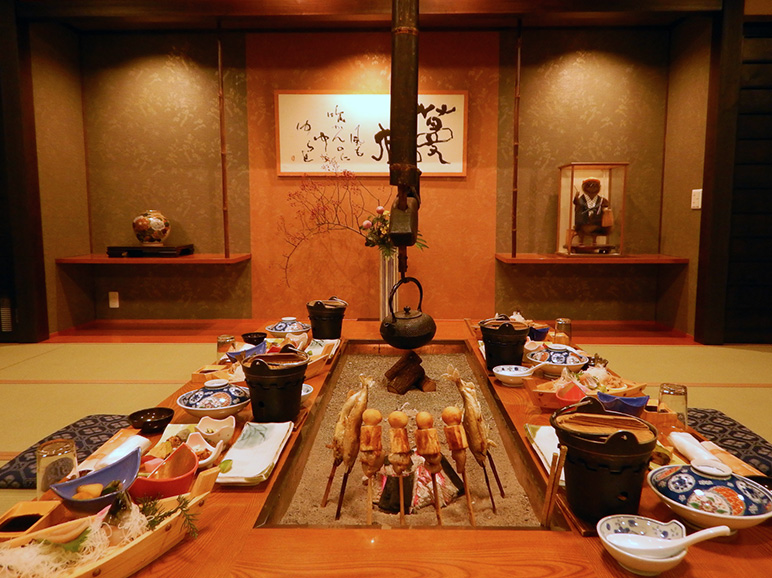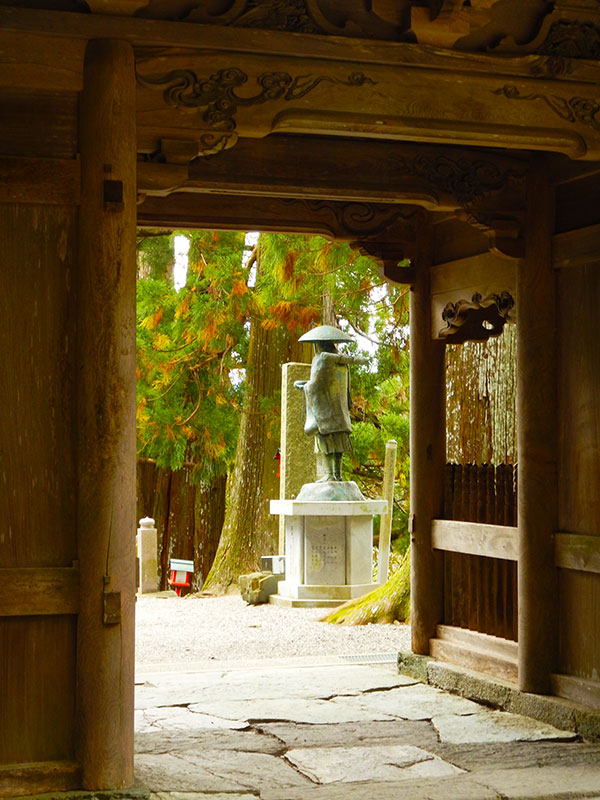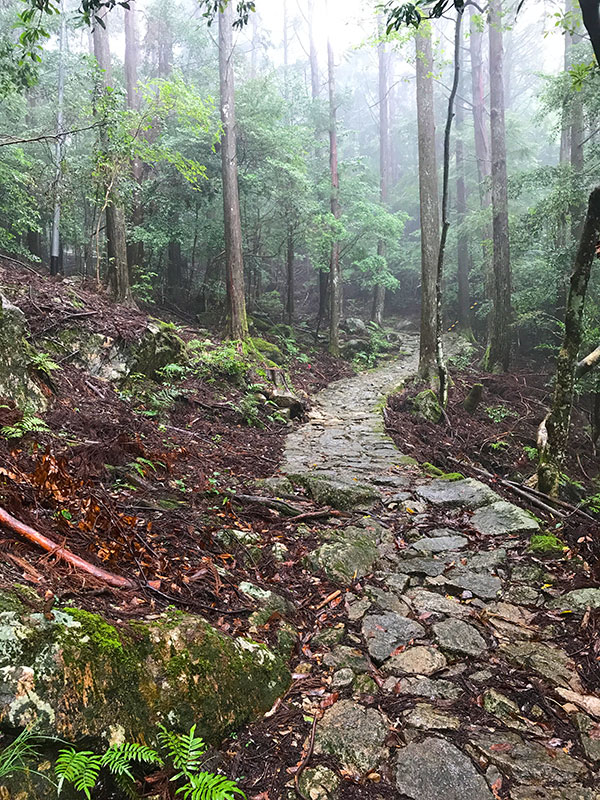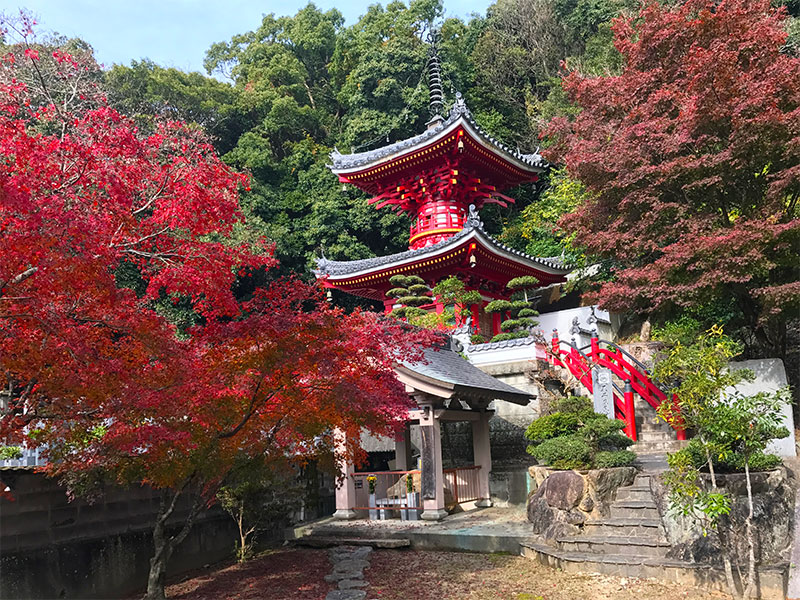A self-guided walking tour following in the steps of Kukai (774–835), founder of the Shingon Buddhist faith, along Shikoku island’s renowned 88-temple pilgrimage.
Remote forest trails and quiet lanes lead from temple to temple through urban landscapes and picturesque mountainous countryside to the Pacific Ocean coast. Stay in temples and inns with onsen thermal hot spring baths and local cuisine.
March - June & September - November.
The Shikoku Wayfarer is a 6-day, 5-night tour starting and finishing in Tokushima. The Shikoku Wayfarer Post-Tour Extension is a 2-night, 3-day optional addition that visits the picturesque Iya Valley, Zentsuji and Kotohira. Tour accommodation is in Japanese inns and hotels. Please read more on accommodation here. For more information please contact us.
The Shikoku Wayfarer Self-Guided Tour takes you deep into the smallest of Japan’s four main islands, a ruggedly beautiful rural and spiritual region deeply associated with Kukai (774–835), one of Japan’s salient spiritual figures, and the famous pilgrimage established in his memory. Kukai, posthumously also known as Kobo Daishi, is revered throughout Japan and to this day many Japanese travel to Shikoku to follow the route linking the pilgrimage’s temples, numbered 1 through to 88.
The whole pilgrimage is a journey through Shikoku’s four provinces; Tokushima, Kochi, Ehime and Kagawa, and is a symbolic and meditative path to nirvana. Temples 1–23 represent the Buddhist notion of awakening; 24–39 austerity and discipline; 40–65 attaining enlightenment; and 66–88 entering nirvana. With such powerful connotations, long history and, at 1,200 kilometres (746 miles), sheer length, the pilgrimage has become deeply engrained into the scenery and daily life of Shikoku.
The whole pilgrimage, journeying from one charming temple to the next strung out along its circular route, takes up to two months. On the 6-day, 5-night Shikoku Wayfarer tour you visit temples found in Tokushima, those associated with Buddhist awakening; while the 3-day, 2-night Shikoku Wayfarer Post-Tour Extension takes you on to Kagawa, where you reach the ultimate destination, nirvana.
On the journey you will join pilgrims, colloquially known as O-henro-san, who are easily identified by their distinctive white clothing, conical sedge hat and wooden staff. The latter item is considered to be the embodiment of Kukai and represents the deep correlation between the pilgrim’s steps and those of Kukai. You may wish to purchase some or all of these items for use on your travels and also a noukyo, a book to obtain the official calligraphy script of each temple you visit. The pilgrimage is open to all, of no matter what, if any, faith; whether making the pilgrimage for ascetic, pious or tourist reasons, locals provide a warm welcome proffering sustenance to all who pass by.
In the modern age, pilgrims travel by many modes of transport including car, bus, taxi and bicycle. We combine some of these for your tour along with the original method on foot. On some days you may also shorten the walking, especially on more arduous sections, by taking one or more of these modern alternatives, or should you wish, lengthen the distance walked. However they travel, all pilgrims make their way to the Daishi-do, a hall enshrining the spirit of Kobo Daishi found at each of the 88 temples, to offer prayers and incense, and recite the Heart Sutra.
The Shikoku Wayfarer tour starts and finishes in Tokushima City; adding the additional Shikoku Wayfarer Post-Tour Extension allows you to continue on from Tokushima to Kotohira. Walk Japan provides tour participants with easily followed, detailed instructions on how to join and leave the tour. For further details please see the itinerary.
Accommodation is mostly in Japanese-style hotels and family-run inns, some with distinctive and traditional Japanese surroundings such as sliding paper shoji doors and straw tatami mat flooring. Onsen thermal hot spring baths, which feature throughout the tour, are a joy to relax in after the day’s walking and also to freshen up in the morning. Your accommodation hosts provide a warm welcome and feasts of home-cooked, local cuisine that appeals both to the eye and the palate.
A Level 4 tour, the route includes undulating forest trails and steeper ascents and descents along sometimes uneven terrain. Participants should be reasonably fit and prepared to walk between four to six hours per day. The materials provided, including the Route Booklet, fully complement this tour and are based on Walk Japan's extensive research of Shikoku and its expertise derived from over 25 years of leading guided walking tours throughout Japan.
The Shikoku Wayfarer includes easy-to-follow, detailed instructions. Daily walking distances are between 3–18.5km (1.8–11.5 miles) and elevation gain averages between 100–1,100m (300–3,600ft). Options may be provided to lengthen or shorten each day’s itinerary to suit your energy levels. There are some ascents on well-maintained forest trail and also up steep stone steps. Care needs to be taken throughout this tour, especially when it is wet underfoot. Your main luggage is transferred for you between each accommodation and includes one overnight courier transfer (two in the case of a combination of the Shikoku Wayfarer tour and the Shikoku Wayfarer Post-Tour Extension). Also included are two transfers by private vehicle to the start and from the end of more remote walking trails, and another transfer by private vehicle to a train station.
What is included?
A Pre-tour Pack. The pack includes details on how to prepare for your Wayfarer Tour, how to travel from your arrival point in Japan to the accommodation at the start of your tour, weather advice, checklist and so forth. Upon receipt of a completed manifest form, your pre-tour pack will be made available for online viewing approximately two months prior to the start date of your tour. It can also be downloaded as a PDF file for offline use.
A Wayfarer Route Booklet. This is provided on arrival at your first night’s accommodation, and is an easily portable booklet. This includes detailed walking directions and logistical information, including maps, photographs and site-specific information such as lunch/cafe recommendations, museum/gallery recommendations and historical points of interest. A rain-resistant pouch and shoulder strap are also provided for ease of carrying the booklet while walking.
Click here for a sample of the Wayfarer booklet.
5-nights’ accommodation, 5 breakfasts and 4 dinners. (Post-Tour Extension: 2-nights' accommodation, 2 breakfasts and 2 dinners).
Main baggage transfer between accommodation including one overnight transfer.
Three private vehicle transfers.
In-country (Japan), 24-hour English-language emergency support.
What is not included?
Not included are flights, lunches and drinks with meals, one dinner and transfers other than those noted in the itinerary.
Please note that Wayfarer self-guided tours sometimes require transfers by public buses and/or trains that are not included in the tour price. This is either because it is not possible to reserve them in advance or to allow maximum flexibility for tour participants. Please contact us for further details.

Please note that on Day 4, your main baggage will be shipped in advance overnight to your final night's accommodation. On this day, you will need to carry all items you require overnight and your daypack should be sufficiently large to accommodate these items.
Day 1 Bando
Your tour starts in the suburbs of Tokushima City at Bando, where you enjoy a leisurely night’s stay in accommodation conveniently located near the start of your walk on Day 2. Those arriving earlier in the day may like to use the time by heading to the Naruto Strait, famed by mariners of old for its ferocious whirlpools, or visiting a unique exhibition documenting the fascinating cultural exchange between locals and German soldiers. The Germans, who had become prisoners of war in China during WWI, formed an orchestra and mounted over 100 concerts during their incarceration, including the first public performance of Beethoven’s Ninth Symphony in Japan.
The Route Booklet, which you receive on check-in at the accommodation, includes details on these suggestions. It also provides advice on how to prepare for the pilgrimage ahead.
Accommodation: Traditional Japanese inn.
Meals: Dinner provided.
Total walking: N/A.
Total elevation gain: N/A.
Day 2 Bando – Anraku-ji
Temples 1, 2, 3, 4, 5 & 6.
After breakfast, begin your pilgrimage with a visit to Ryozen-ji, the first of the Shikoku Pilgrimage’s 88 temples. Within the temple precincts, aspiring pilgrims, known locally as O-henro-san, prepare for their journey by acquiring the distinctive accoutrements of white garb, sedge hat, walking staff and praying beads. You may wish to add some or all of these items to your walking gear. Certainly, however, make sure to obtain Ryozen-ji’s goshuin, or temple stamp. These elegantly handwritten inscriptions are collected by pilgrims, one for each temple they visit.
Readied, you begin your pilgrimage; a journey of stages on a symbolic path to nirvana. From here to Yakuo-ji, temple 23, on Day 5 is the first of the four stages: awakening.
The pilgrimage route from here is generally flat and wends its way past paddy fields, plum orchards, market gardens and a towering kusunoki camphor tree, which has stood watch over pilgrims for centuries, as you make your way from temple to temple. Lunch is taken near Konsen-ji, the third of the 88 temples, and options include dining on udon wheat noodles, a popular Shikoku speciality, or eating al fresco with morsels bought in the local shops. The pilgrimage continues on, sometimes through quiet residential suburbs and at other times over gentle rises through forests to the fourth and fifth temples, respectively Dainichi-ji and Jizo-ji. The latter features a collection of over 200 rakan statues of Buddhist disciples, and an 800-year old ginko tree. A little further on is Anraku-ji, the sixth temple and your destination for the day.
Accommodation is in the temple’s shukubo pilgrims’ lodging. Here, enjoy a well-earned relaxing soak in the onsen thermal hot spring baths before a delicious and nourishing dinner. Take the opportunities available to guests to visit the temple’s inner sanctum, view its holy treasures and participate in prayers.
For those who would like a further challenge, the route booklet provides details on a walk to the pilgrimage’s seventh temple, Juraku-ji. Conversely, taxis can be used easily to shorten today’s walking.
Accommodation: Shukubo pilgrim lodging.
Meals: Breakfast & dinner provided.
Total walking: 18km (11 miles).
Total elevation gain: 130m (427ft).
Day 3 Anraku-ji – Shosan-ji – Kamiyama Onsen
Temples 11 & 12.
Enjoy breakfast in your accommodation before transferring by a reserved/pre-paid vehicle to Fujii-dera, number 11 of the 88 temples. Today’s walk, which starts here, passes through forests and includes some long mountain trails over three peaks. One trail section is colloquially known as henro-korogashi, the pilgrim tumbler, and care needs to be taken here especially in wet weather. Small shrines placed to either side of the path guide you on your way, as does Ippon-sugi-an, an ancient sugi cedar tree of great girth under which stands a serene statue of Kukai. A delightful farming hamlet heralds your arrival at Shosan-ji, Temple 12. Standing on top a mountain 800 metres above sea level, Shosan-ji is known for its spectacular setting amongst giant sugi cedar trees, the tops of which often disappear into enveloping mists.
Beyond, the pilgrimage trail descends into a small valley town, where a transfer by reserved vehicle brings you to tonight’s accommodation in Kamiyama Onsen. Kamiyama, which literally means 'Mountains of the Gods', is an entirely appropriate name for this beautiful village. Relax and enjoy a well-earned bask in the accommodation’s onsen baths before tucking into a traditional kaiseki dinner, a meal composed of multiple delicious dishes.
For those who prefer a more relaxed day, details are provided in the route booklet to reduce the walking by approximately seven kilometres and ascent gain by 580 metres.
Accommodation: Japanese-style hotel with onsen hot spring baths.
Meals: Breakfast & dinner provided.
Total walking: 16.5km (10.3 miles).
Total elevation gain: 1083m (3,553ft).
Day 4 Kakurin-ji – Tairyu-ji – Naka
Temples 20 & 21.
After breakfast a reserved/pre-paid taxi transfers you to either the base of a climb to Kakurin-ji, Temple 20, or directly to the temple itself. The former choice entails an ascent of 470 metres over four kilometres through beautiful forests. From Kakurin-ji the route follows an undulating forest trail and cobblestone paths down to a quiet mountain village. Cross the Naka-gawa river and begin today’s final ascent though native woodlands aside cascading streams to Tairyu-ji, Temple 21. Secluded at the top of a pass and often draped in mist, Tairyu-ji is an ethereal embodiment of the spirit of the Shikoku Pilgrimage. After absorbing the serene atmosphere, a cable car eases the journey down to the town far below. A short distance away by local bus is your evening’s accommodation, which is set aside a quiet river. Relax once again in the onsen baths here before a hearty dinner.
Accommodation: Japanese-style hotel with onsen hot spring baths.
Meals: Breakfast & dinner provided.
Total walking: 15km (9.3 miles).
Total elevation gain: 910m (3,000ft).
Day 5 Naka – Hiwasa – Tokushima
Temple 23.
Your morning starts with a scenic three kilometre walk along the Naka-gawa river. A hydroelectric dam provides the means to cross the river to reach a bus stop, from where a bus takes you on a gentle and scenic jaunt to Hiwasa, a quiet fishing town. The pagoda at Yakuo-ji, the 23rd temple on the Shikoku Pilgrimage, presides over the town and can be seen from miles away. From its top, a beautiful view is afforded over Hiwasa to the Pacific Ocean.
From here, a six kilometre looping walk leads you past Hiwasa Castle to a coastal ridge trail. Well-exercised pilgrim’s legs will have no trouble navigating the ups and downs of this forest trail, which opens up repeatedly to views over the steely-blue sea.
Return to Hiwasa’s town centre for journey by train to Tokushima City and your hotel accommodation for the night. Although dinner is not included this evening, the Route Booklet provides recommendations for making the most of the local fare including Tokushima ramen, Awaodori chicken, Naruto sea bream, and Sanuki udon noodles.
For those preferring a more relaxing time in Hiwasa, an option is available for a leisurely five-kilometre stroll through the town. This includes a visit to Ohama Beach, where loggerhead sea turtles spawn from May through August.
Accommodation: Western-style hotel.
Meals: Breakfast provided.
Total walking: 11.1km (6.9 miles).
Total elevation gain: 200m (656ft).
Day 6 Tokushima
The core five-night tour ends here with breakfast at the hotel. Convenient access to the station allows for ease of onward travel.
Accommodation: N/A.
Meals: Breakfast provided.
Total walking: N/A.
Total elevation gain: N/A.
This itinerary is subject to change.
The optional Post-Tour Extension for the Shikoku Wayfarer Self-guided Tour is ground-only, beginning in Tokushima and ending in Kotohira. This extension cannot be undertaken separately from the standard itinerary.
Day 6 Tokushima – Iya Valley
Temples 13, 14, 15, 16 & 17.
Today, a walk through suburban Tokushima furthers your symbolic awakening with visits to Dainichi-ji, Joraku-ji, Kokubunji, Kannon-ji and Ido-ji – respectively Temples 13 through 17. From here a transfer by train brings you to the verdant Iya Valley and the famed kazura-bashi, a 45m-long vine bridge suspended 14 metres above the Iya River. With its uneven and widely-spaced wooden slats, with views to the river below and gentle swaying, crossing this bridge can be a thrill for even an adventurous individual. (Those who are more thrill-averse can view the bridge from afar or from the riverbed below). Otherwise, spend your time here enjoying the beauty of the mountainous valley, waterfalls and limpid river water.
An option for those who wish to skip the walking in Tokushima includes a short sightseeing boat ride through Iya's Oboke Gorge. Your accommodation tonight is a Japanese-style hotel well-known for its roten-buro outdoor onsen baths, impressive views of the surrounding mountains and charming hostess.
Accommodation: Modern Japanese inn with onsen hot spring baths.
Meals: Breakfast & dinner provided.
Total walking: 14.5km (9 miles).
Total elevation gain: 50m (164ft).
Day 7 Iya Valley – Zentsuji – Kotohira
Temples 71, 72, 73, 74 & 75.
Today, you enter nirvana, the final Buddhist stage, after being fast-tracked through the stages both of austerity and discipline, and of attaining enlightenment. After a hearty breakfast transfer by taxi to the nearest station for transfer to the town of Zentsuji, the birthplace and spiritual home of Kukai. Although the 75th temple, Zentsu-ji is located only one kilometre from the station, in keeping with the spirit of the pilgrimage we recommend a 14-kilometre walk through mixed forest and along quiet country lanes to Temples 71 through 75 as a final flourish to your tour.
From here, the pilgrimage winds its way through bamboo groves, aside paddy fields and through charming hamlets to Mandara-ji, Shusshaka-ji and Koyama-ji, respectively Temples 72, 73 and 74, before reaching Zentsu-ji, Kukai’s birthplace. Here, an impressive five-storey pagoda towering over the precincts competes for attention with a gnarled kusunoki camphor tree, which reputedly has existed since the age of Kukai himself. Underneath the main hall, a pitch-black 100-metre tunnel provides the intriguing symbolic experience of passing through Buddhist purification to be reborn as one resurfaces into the daylight.
Transfer by local train to nearby Kotohira, where your accommodation once again includes onsen baths, for the perfect way to relax and revive in before dinner.
Accommodation: Onsen hot spring resort.
Meals: Breakfast & dinner provided.
Total walking: 14km (8.7miles).
Total elevation gain: 142m (466ft).
Day 8 Kotohira
After breakfast, explore Kotohira, a town known not only for its onsen but also for Konpira-san, Shikoku’s most visited Shinto shrine. A series of 785 steps rises up and through the shrine’s precincts to the main hall. For those with the will power, another 583 steps bring you to the shrine’s inner sanctum, where extensive views are afforded across the surrounding countryside. For the weary of foot, either hire a palanquin to take you to the top or jump on a bus.
Onward journey is easily made from Kotohira by train to Kochi, Takamatsu, Okayama and destinations further afield in Japan.
Accommodation: N/A
Meals: Breakfast provided.
Total walking: approximately 3km (1.9 miles).
Total elevation gain: 180m (590ft).
This itinerary is subject to change.
-----
FROM TOKYO’S HANEDA AIRPORT (HND)
Domestic flights between Tokyo’s Haneda Airport and Tokushima Awaodori Airport (TKS) take 1 hour 10 minutes. On arrival, airport buses depart for Tokushima Station. The journey takes approximately 30 minutes. From here, take a 20-minute train journey on the Kotoku Line to Bando station.
-----
FROM FUKUOKA AIRPORT (FUK)
Domestic flights between Fukuoka Airport and Tokushima Awaodori Airport (TKS) take 60 minutes. On arrival, airport limousine buses depart for Tokushima Station. The journey takes approximately 30 minutes. From here, take a 20-minute train journey on the Kotoku Line to Bando station.
-----
FROM OSAKA’S KANSAI INTERNATIONAL AIRPORT (KIX)
From Osaka’s Kansai International Airport, JR Haruka Express trains depart for Shin-Osaka Station. Transfer here to the Tokaido Shinkansen bullet train for Okayama. At Okayama, transfer to the limited express for Tokushima Station. From here, take a 20-minute train journey on the Kotoku Line to Bando station.
-----
BY TRAIN
Travel to Tokushima City can also be made by train – a round-about but interesting journey. Travel to Okayama by shinkansen bullet train for transfer by the Marine Liner express train over the Seto Ohashi Bridge to Takamatsu. From Takamatsu travel to Tokushima on the Uzushio express train. From here, take a 20-minute train journey on the Kotoku Line to Bando station.
The pre-tour pack includes more detailed instructions, including a map, for travel to the accommodation at the start of the tour.










































